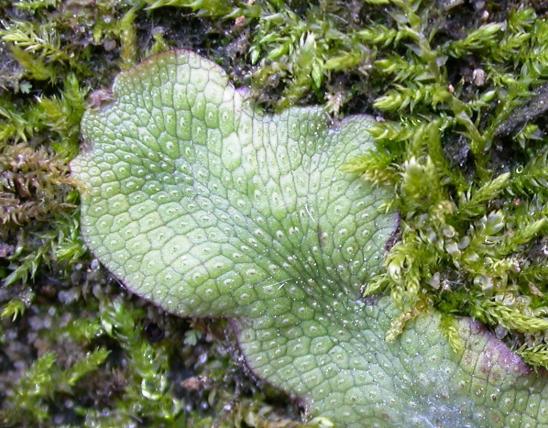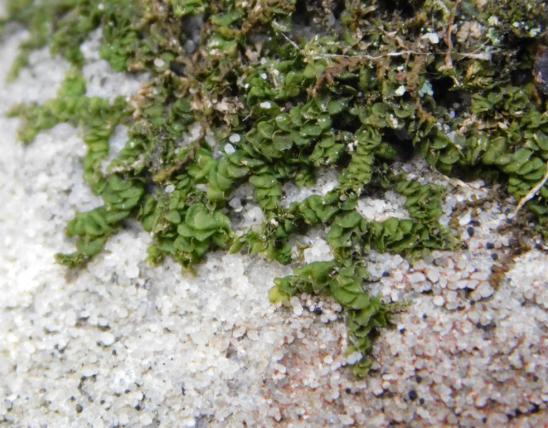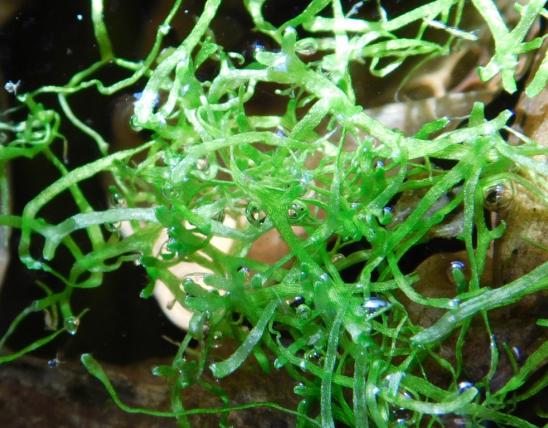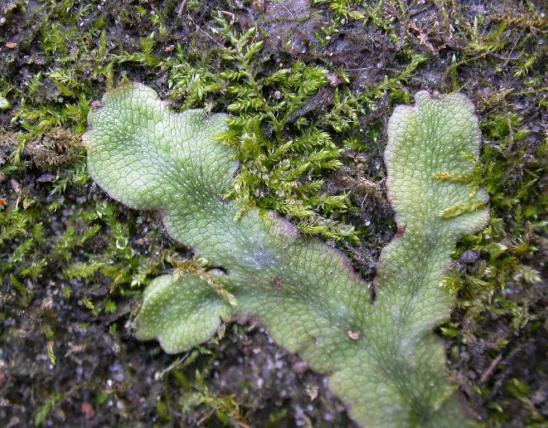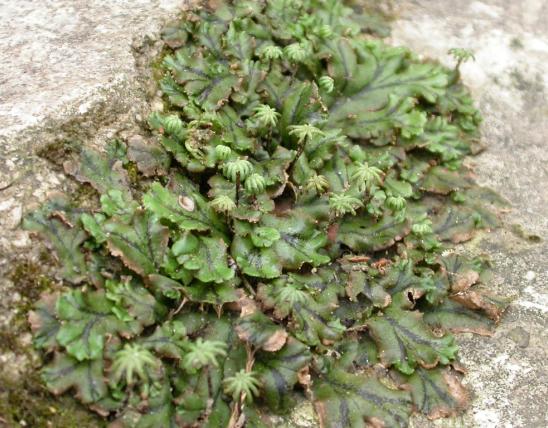
New York scalewort is the most common and easily recognized leafy or scaly liverwort. It forms tiny, delicate traceries on tree bark and is usually rusty or purplish red, sometimes green, or green at the tips. The tiny leafy structures are alternate, tightly pressed to the substrate, and look more like knobs or scales than leaves.
This species and other leafy liverworts are often mistaken for mosses, perhaps because few people know that liverworts can have this tiny leafy or scaly form.
Like most other frullanias, New York scalewort typically grows flat against the bark of trees and shrubs, in a branching, lacy pattern. The overall spread may be about 4 inches in diameter. It may be dark olive green, brownish, reddish, or purplish. The color is usually green in summer, turning darker in winter. The round, alternate leaves lie in 2 (apparent) rows, have no midribs, and typically overlap each other.
A closer look: Helmet-shaped leaf appendages (you’ll need a microscope to see these), formed by folded-over lobes at the bases of the leaves, can store water and help these tiny plants survive relatively dry situations. Also, a third row of very tiny leaves, called underleaves, occur along the underside of each stem and are pressed tightly against the stem. You will need a microscope to examine them well.
Liverworts, like mosses, are land plants that do not have a vascular system. Their lack of veinlike tubes to conduct moisture and nutrients throughout the plant limits them to a small size. They produce spores instead of seeds. Their form of reproduction usually requires them to be in wet or moist places. Learn more about liverworts on their group page.
To identify liverworts to species, specialists examine details of the plant’s reproductive structures. Unfortunately, the reproductive structures of leafy liverworts are obscure, variable, and hard for an amateur botanizer to see.
Similar species: Missouri has 7 or 8 other species in genus Frullania; all are called scaleworts. The millipede liverwort (F. inflata), and another species, F. riparia, are two that are also rather widely distributed. Like New York scalewort, they are usually overlooked by most people.
Missouri has about 36 genera of leafy or scaly liverworts.
Width: A patch is usually no more than about 4 inches wide. An individual stem, including the leaves on both sides, is usually no more than about 1 mm wide.
Statewide.
Habitat and Conservation
New York scalewort usually grows on the bark of fairly mature deciduous trees, notably on the trunks as opposed to branches. Because of its nifty, helmet-shaped leaf-lobe pouches, which can store water, this liverwort can live in drier situations than other liverworts. Look for it in wooded natural areas such as rocky woodland slopes, bottomlands, and near streams, as well as cemeteries, parks, and other places with mature trees.
This is the most common leafy liverwort in eastern North America, and since it grows on tree trunks — often chest-high — this is probably the first leafy liverwort you will see and identify.
Status
The most commonly encountered leafy/scaly liverwort in Missouri.
Life Cycle
Unfortunately, the reproductive structures of this and other leafy or scaly liverworts are too tiny and obscure for most amateurs to see. As with other liverworts and mosses, this species has alternating generations: the plant we usually think of as New York scalewort is a gametophyte, which has organs that produce gametes (sperm or eggs; different plants are male and female).
The gametes unite and give rise to a sporophyte, technically a separate plant. It grows out of the female organ of the gametophyte and is a white-stalked, rounded, brown or black, spore-bearing capsule that persists for only a few weeks in springtime. At maturity, the capsules release spores that can become new gametophytes.
Like other liverworts, this species can also reproduce vegetatively (asexually) by cuttings, when a portion of the plant is broken off gets moved to a new location. This species can also form very tiny buds called gemmae along the margins of the leaves; the gemmae can easily break off and begin a new plant elsewhere.
Human Connections
The name: During ancient times, when much of the island of Great Britain was the Roman province of Britannia, the Romans called the English town of York “Eboracum.” The species name for this plant is ultimately derived from this name. However, the plant is actually named for America’s New York — not the York in England.
Once you become aware of these tiny, graceful, fascinating plants, you might start seeing them everywhere. This particular scalewort is so common and widespread, people who are into bryophytes sometimes jokingly call it “e-boring-censis.” Once you learn to identify this species, you can be in on the joke!
Now is a great time to learn about liverworts and mosses, because there is so much information available online. Before the Internet, you needed access to heavy reference manuals and scholarly journals, whose pictures were limited by publishers’ budgets. Today, photographs abound, and information is available at all skill levels.
Ecosystem Connections
A 2004 study found that rotifers often live in the tiny, water-filled pockets formed by the folded-over leaf lobes of this species. Rotifers, sometimes called wheel animals, are microscopic animals that usually live as zooplankton in freshwater. Not much is known about how this relationship with scalewort may benefit either of the two life-forms.
A variety of microscopic and near-microscopic invertebrate animals — such as mites, water bears (tartigrades), and roundworms — are associated with liverworts and mosses, but little is known of the effects these organisms have on each other. Compared to our knowledge of pollinating or plant-eating insects and flowering plants, the amount we know about these smaller organisms is very limited.
In spring, many birds hunt in woodlands for soft, fibrous nesting materials, and liverworts and mosses are certainly among those used. Prothonotary warblers have been recorded using New York scalewort in nest construction.


















Mosses, liverworts, hornworts, and lichens seem rather similar, but these organisms are in very different groups. Mosses, liverworts, and hornworts are small, low plants usually found in damp habitats. Unlike more familiar plants, they lack veinlike structures and do not produce flowers or seeds — instead, they produce spores. Meanwhile, lichens are not plants at all: they are a collection of different fungi that have photosynthetic algae living within their tissues.






















